Conservation lesson for Dromore visitors


The visitors were guests of renowned honey bee breeder John Summerville, who runs a breeding programme at his apiary on the outskirts of Tullamore.
Froim there he supplies native ‘black’ queens to beekeepers throughout Ireland.
Advertisement
Hide AdAdvertisement
Hide AdThe native ‘black’ honey bee is said to be better adapted to the cooler, damper climate of the British Isles than imported honey bees of the Italian strain.
A spokesperson said: “In particular, the native strain of honey bee is hardy and frugal, enabling them to survive our long damp winters and sometimes inclement summers.”
During the visit John Sumerville and his team demonstrated the four main stages of the queen rearing process, namely, confining the breeder queen using the Cupkit technique to harvest eggs to be raised as queens; transfer of larvae to starter colonies to initiate the development of queen cells; subsequent transfer into finisher colonies to complete the queen cell development, and introduction of the emerged unmated queens into mini colonies for mating.
The Dromore visitors enjoyed an informative day and presented their host with a copy of the book ‘Pollen: The Hidden Sexuality of Flowers’, as a mark of appreciation.